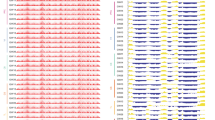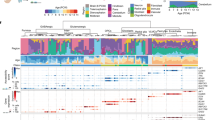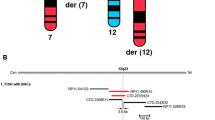Abstract
Patients with terminal deletions of chromosome 6q present with structural brain abnormalities including agenesis of corpus callosum, hydrocephalus, periventricular nodular heterotopia, and cerebellar malformations. The 6q27 region harbors genes that are important for the normal development of brain and delineation of a critical deletion region for structural brain abnormalities may lead to a better genotype–phenotype correlation. We conducted a detailed clinical and molecular characterization of seven unrelated patients with deletions involving chromosome 6q27. All patients had structural brain abnormalities. Using array comparative genomic hybridization, we mapped the size, extent, and genomic content of these deletions. The smallest region of overlap spans 1.7 Mb and contains DLL1, THBS2, PHF10, and C6orf70 (ERMARD) that are plausible candidates for the causation of structural brain abnormalities. Our study reiterates the importance of 6q27 region in normal development of brain and helps identify putative genes in causation of structural brain anomalies.
Similar content being viewed by others
Log in or create a free account to read this content
Gain free access to this article, as well as selected content from this journal and more on nature.com
or
References
Eash D, Waggoner D, Chung J, Stevenson D, Martin CL : Calibration of 6q subtelomere deletions to define genotype/phenotype correlations. Clin Genet 2005; 67: 396–403.
Bertini V, De Vito G, Costa R, Simi P, Valetto A : Isolated 6q terminal deletions: an emerging new syndrome. Am J Med Genet A 2006; 140: 74–81.
Sherr EH, Owen R, Albertson DG et al: Genomic microarray analysis identifies candidate loci in patients with corpus callosum anomalies. Neurology 2005; 65: 1496–1498.
Rooms L, Reyniers E, Scheers S et al: TBP as a candidate gene for mental retardation in patients with subtelomeric 6q deletions. Eur J Hum Genet 2006; 14: 1090–1096.
Elia M, Striano P, Fichera M et al: 6q terminal deletion syndrome associated with a distinctive EEG and clinical pattern: a report of five cases. Epilepsia 2006; 47: 830–838.
Striano P, Malacarne M, Cavani S et al: Clinical phenotype and molecular characterization of 6q terminal deletion syndrome: five new cases. Am J Med Genet A 2006; 140: 1944–1949.
Mosca AL, Callier P, Masurel-Paulet A et al: Cytogenetic and array-CGH characterization of a 6q27 deletion in a patient with developmental delay and features of Ehlers-Danlos syndrome. Am J Med Genet A 2010; 152A: 1314–1317.
Gerber JC, Neuhann TM, Tyshchenko N, Smitka M, Hackmann K : Expanding the clinical and neuroradiological phenotype of 6q27 microdeletion: olfactory bulb aplasia and anosmia. Am J Med Genet A 2011; 155A: 1981–1986.
Rigon C, Salviati L, Mandarano R, Dona M, Clementi M : 6q27 subtelomeric deletions: is there a specific phenotype? Am J Med Genet A 2011; 155A: 1213–1214.
O'Driscoll MC, Black GC, Clayton-Smith J, Sherr EH, Dobyns WB : Identification of genomic loci contributing to agenesis of the corpus callosum. Am J Med Genet A 2010; 152A: 2145–2159.
El-Hattab AW, Smolarek TA, Walker ME et al: Redefined genomic architecture in 15q24 directed by patient deletion/duplication breakpoint mapping. Hum Genet 2009; 126: 589–602.
Boone PM, Bacino CA, Shaw CA et al: Detection of clinically relevant exonic copy-number changes by array CGH. Hum Mutat 2010; 31: 1326–1342.
Ou Z, Kang SH, Shaw CA et al: Bacterial artificial chromosome-emulation oligonucleotide arrays for targeted clinical array-comparative genomic hybridization analyses. Genet Med 2008; 10: 278–289.
Gu W, Zhang F, Lupski JR : Mechanisms for human genomic rearrangements. PathoGenet 2008; 1: 4.
Shen-Schwarz S, Hill LM, Surti U, Marchese S : Deletion of terminal portion of 6q: report of a case with unusual malformations. Am J Med Genet 1989; 32: 81–86.
Birnbacher R, Chudoba I, Pirc-Danoewinata H et al: Microdissection and reverse painting reveals a microdeletion 6(q26qter) in a de novo r(6) chromosome. Ann Genet 2001; 44: 13–18.
Artavanis-Tsakonas S, Rand MD, Lake RJ : Notch signaling: cell fate control and signal integration in development. Science 1999; 284: 770–776.
Lui JH, Hansen DV, Kriegstein AR : Development and evolution of the human neocortex. Cell 2011; 146: 18–36.
Bettenhausen B, Hrabe de Angelis M, Simon D, Guenet JL, Gossler A : Transient and restricted expression during mouse embryogenesis of Dll1, a murine gene closely related to Drosophila Delta. Development 1995; 121: 2407–2418.
Lathia JD, Mattson MP, Cheng A : Notch: from neural development to neurological disorders. J Neurochem 2008; 107: 1471–1481.
Hrabe de Angelis M, McIntyre J 2nd, Gossler A : Maintenance of somite borders in mice requires the Delta homologue DII1. Nature 1997; 386: 717–721.
Rubio-Aliaga I, Przemeck GK, Fuchs H et al: Dll1 haploinsufficiency in adult mice leads to a complex phenotype affecting metabolic and immunological processes. PloS one 2009; 4: e6054.
Dupe V, Rochard L, Mercier S et al: NOTCH, a new signaling pathway implicated in holoprosencephaly. Hum Mol Genet 2011; 20: 1122–1131.
Armstrong LC, Bornstein P : Thrombospondins 1 and 2 function as inhibitors of angiogenesis. Matrix Biol 2003; 22: 63–71.
Adams JC : Thrombospondins: multifunctional regulators of cell interactions. Ann Rev Cell Dev Biol 2001; 17: 25–51.
Kyriakides TR, Leach KJ, Hoffman AS, Ratner BD, Bornstein P : Mice that lack the angiogenesis inhibitor, thrombospondin 2, mount an altered foreign body reaction characterized by increased vascularity. Proc Natl Acad Sci USA 1999; 96: 4449–4454.
Tian W, Sawyer A, Kocaoglu FB, Kyriakides TR : Astrocyte-derived thrombospondin-2 is critical for the repair of the blood-brain barrier. Am J Pathol 2011; 179: 860–868.
Meng H, Zhang X, Hankenson KD, Wang MM : Thrombospondin 2 potentiates notch3/jagged1 signaling. J Biol Chem 2009; 284: 7866–7874.
Yoo AS, Staahl BT, Chen L, Crabtree GR : MicroRNA-mediated switching of chromatin-remodelling complexes in neural development. Nature 2009; 460: 642–646.
Conti V, Carabalona A, Pallesi-Pocachard E et al: Periventricular heterotopia in 6q terminal deletion syndrome: role of the C6orf70 gene. Brain 2013; 136 (Pt 11): 3378–3394.
Trachtulec Z, Forejt J : Synteny of orthologous genes conserved in mammals, snake, fly, nematode, and fission yeast. Mamm Genome 2001; 12: 227–231.
Trachtulec Z, Vlcek C, Mihola O, Forejt J : Comparative analysis of the PDCD2-TBP-PSMB1 region in vertebrates. Gene 2004; 335: 151–157.
Hong EJ, West AE, Greenberg ME : Transcriptional control of cognitive development. Curr Opin Neurobiol 2005; 15: 21–28.
Merla G, Howald C, Henrichsen CN et al: Submicroscopic deletion in patients with Williams-Beuren syndrome influences expression levels of the nonhemizygous flanking genes. Am J Hum Genet 2006; 79: 332–341.
Acknowledgements
We thank all the patients and their family members for their cooperation and participation in this research study. We also thank all the research coordinators at BCM-MGL for their assistance in obtaining clinical information. This work was supported in part by fellowship grants by the Clinical Scientist Development Award from The Doris Duke Charitable Foundation (SNSC), DK081735-01A1, NIH /NIGMS T32 contract grant number GM07526 (AE).
Author information
Authors and Affiliations
Corresponding author
Ethics declarations
Competing interests
The authors declare no conflict of interest.
Additional information
Supplementary Information accompanies this paper on European Journal of Human Genetics website
Rights and permissions
About this article
Cite this article
Peddibhotla, S., Nagamani, S., Erez, A. et al. Delineation of candidate genes responsible for structural brain abnormalities in patients with terminal deletions of chromosome 6q27. Eur J Hum Genet 23, 54–60 (2015). https://doi.org/10.1038/ejhg.2014.51
Received:
Revised:
Accepted:
Published:
Issue date:
DOI: https://doi.org/10.1038/ejhg.2014.51
This article is cited by
-
The phenotypic spectrum of terminal 6q deletions based on a large cohort derived from social media and literature: a prominent role for DLL1
Orphanet Journal of Rare Diseases (2023)
-
Differences in whole-brain metabolism are associated with the expression of genes related to neurovascular unit integrity and synaptic plasticity in temporal lobe epilepsy
European Journal of Nuclear Medicine and Molecular Imaging (2023)
-
Multiple genomic copy number variants associated with periventricular nodular heterotopia indicate extreme genetic heterogeneity
European Journal of Human Genetics (2019)
-
Williams–Beuren syndrome in Mexican patients confirmed by FISH and assessed by aCGH
Journal of Genetics (2019)
-
A feasible diagnostic approach for the translocation carrier from the indication of products of conception
Molecular Cytogenetics (2018)



